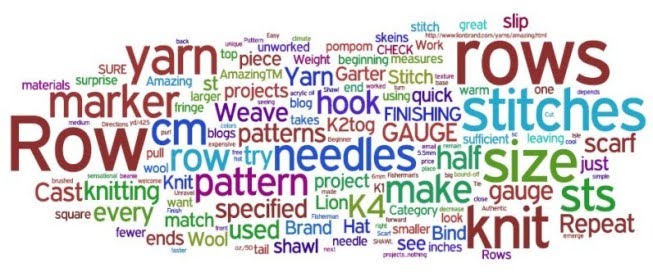 Diagonal knitting is a wonderful way to use up odds and ends, as gauges
Diagonal knitting is a wonderful way to use up odds and ends, as gaugesdon’t need to match exactly and neither do back, front and
sleeves. Our sample shell uses lots of different size 3 yarns for a
fun, gradated look. Here are some hints for succesfully knitting on
the diagonal:
• Garter stitch is the easiest, because the stitch to row ratio is
1:2. A typical garter stitch gauge might be 4 sts and 8 rows
per inch. To make a square (90⁰) angle, one stitch at each end
should be increased every two rows (every other row).
• Stockinette is tougher, as the stitch to row ratio is closer to
2:3. A typical stockinette stitch gauge might be 4 sts and 6
rows per inch. If increases were made every other row as
for garter, the angle would be wider than 90⁰, and any seam
would twist around the body instead of being vertical.
So forstockinette stitch, increase at each edge for two consecutive
rows, then work one row even with no shaping. That gives a
six row repeat:
Row 1: K and increase.
Row 2: P and increase.
Row 3: K.
Row 4: P and increase.
Row 5: K and increase.
Row 6: P and increase.
• Make increases in the first stitch, and in the next to last stitch
to balance them. Make increases by knitting in the front, then
in the back of each stitch.
• Always measure along the selvedge edge, not from the corner
to the needle.
• Once you have reached the dimension you want, shape
the other corners by decreasing: work ssk or ssp at beg of
appropriate rows and k 2 tog or p 2 tog at end of appropriate
rows, depending on whether you are working garter or
stockinette stitch.
• If you want a piece that is longer than it is wide, work to
the width, then continue to increase at one end while you
decrease at the other end. Do this for as long as the piece
needs to be, then begin decreasing at both ends. Once you
begin to increase at one end and decrease at the other, even
if you are working stockinette stitch you can work every other
row without throwing the corners out of square. Whether you
increase or decrease at the beginning or end will determine
what direction the stripes will run, which becomes important
when trying to match fronts and backs.
Sizes: S (M, L, XL)
Finished bust approx 40 (44, 48, 52)”
Body is slightly oversized to allow for drape.
Materials: approx 700 (800, 900, 1000) yds size 3 & 4 yarns,
plus 80 yds trim yarn
Used here a variety of Prism size 3 & 4 yarns, including:
Dazzle,Super Dazzle, Tulle, Trieste, Frost, Azalea, Bon Bon, Tencel, Pinot, Flirt, Cleo, Sushine
In colors that include:
Harvest, Blue Lagoon, Captiva, Orchard, Mojave, Arroyo
Needles size 8 or size to get gauge
Crochet hook size E & F
Gauge: In garter st alternating 3 yarns of 1 row each:
18 sts & 34 rows = 4”
Note: Gradated color blending is easy. Before beginning, lay all yarns
out lightest to darkest. If you have purchased a kit, the skeins are
already labeled A, B, C, etc. Label your own custom choice as needed.
3 different yarns are used for 1 row each:
CO with A; drop A and attach B; k 1 row B; drop B and attach C; k 1 row
C and A is waiting for next row. To keep yarns from tangling, place one
ball on either side and one ball between your legs, and watch when
you turn the work: one direction tangles, the other direction does
not. Color gradation is achieved by working A, B, C for a few inches,
then B, C, D, then C, D, E and so on, arranging colors loosely from light
to dark. Work front as mirror image of back (begin from other corner).
Work back first, then work front approximating color placement—it
doesn’t have to match exactly. Work more rows of yarns with more
yardage, even if it means that sometimes a yarn is used for longer
than its rotation. As you work, check remaining amounts of yarn
and make any adjustments. Don’t worry about breaking the rotation
and repeating a yarn if needed—we did! We had 9 different yarns,
labeled A through I. Adjust measurements below if you have more
or fewer yarns.
Back: With A, CO 3 sts. With B, inc 1 in first st, k to end. With C,
inc 1 in first st, k to end. Inc in the first st on all rows. Make all
measurements along selvedge edge, not from corner to needle.
Work A, B, C to approx 6 (7, 8, 9)”, then drop A and add D. Work B,
C, D to approx 12”, then drop B and add E.
Work C, D, E to approx 17”.
Work D, E, F to 20 (22, 24, 26)”, then cont on D, E, F, beg dec: work
to end of row, k 2 tog last 2 sts. Measuring from 1st decrease, cont in
D, E, F to approx 3” from corner.
Work E, F, G to approx 8”.
Work F, G, H for to approx 14”.
Work G, H, I to approx 20 (22, 24, 26)”: When 1 st remains, fasten
off.
Front: Repeat as for back.
Finishing: Sew shoulder seams, leaving approx 7 (8, 8½, 9)” open for
neck. Sew side seams, leaving approximately 3-4” open at hem for
side slit. With trim yarn, work 1 row sc and 1 row rev sc around hem
and slits, and around neck and armhole openings.












No comments:
Post a Comment